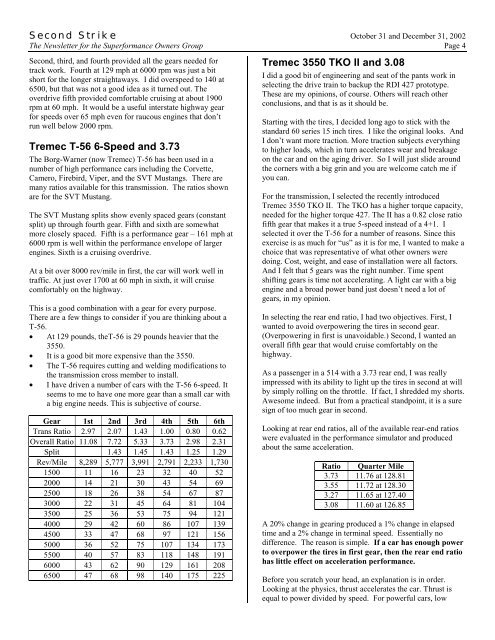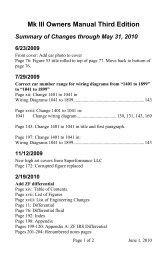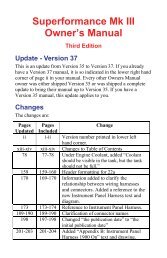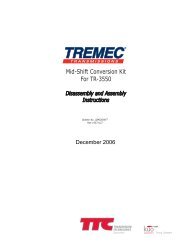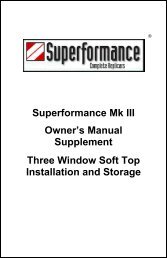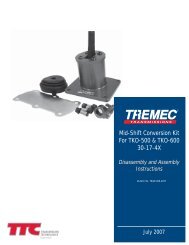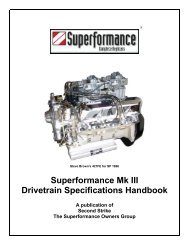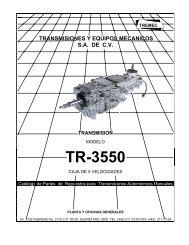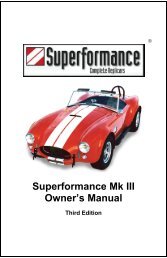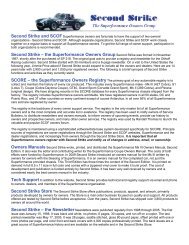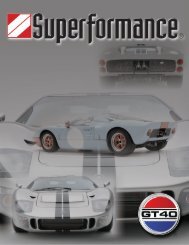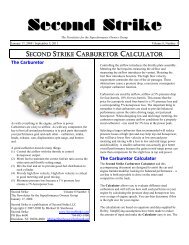SECOND STRIKE GEARING CALCULATOR - Second Strike - the ...
SECOND STRIKE GEARING CALCULATOR - Second Strike - the ...
SECOND STRIKE GEARING CALCULATOR - Second Strike - the ...
You also want an ePaper? Increase the reach of your titles
YUMPU automatically turns print PDFs into web optimized ePapers that Google loves.
<strong>Second</strong> <strong>Strike</strong> October 31 and December 31, 2002<br />
The Newsletter for <strong>the</strong> Superformance Owners Group Page 4<br />
<strong>Second</strong>, third, and fourth provided all <strong>the</strong> gears needed for<br />
track work. Fourth at 129 mph at 6000 rpm was just a bit<br />
short for <strong>the</strong> longer straightaways. I did overspeed to 140 at<br />
6500, but that was not a good idea as it turned out. The<br />
overdrive fifth provided comfortable cruising at about 1900<br />
rpm at 60 mph. It would be a useful interstate highway gear<br />
for speeds over 65 mph even for raucous engines that don’t<br />
run well below 2000 rpm.<br />
Tremec T-56 6-Speed and 3.73<br />
The Borg-Warner (now Tremec) T-56 has been used in a<br />
number of high performance cars including <strong>the</strong> Corvette,<br />
Camero, Firebird, Viper, and <strong>the</strong> SVT Mustangs. There are<br />
many ratios available for this transmission. The ratios shown<br />
are for <strong>the</strong> SVT Mustang.<br />
The SVT Mustang splits show evenly spaced gears (constant<br />
split) up through fourth gear. Fifth and sixth are somewhat<br />
more closely spaced. Fifth is a performance gear – 161 mph at<br />
6000 rpm is well within <strong>the</strong> performance envelope of larger<br />
engines. Sixth is a cruising overdrive.<br />
At a bit over 8000 rev/mile in first, <strong>the</strong> car will work well in<br />
traffic. At just over 1700 at 60 mph in sixth, it will cruise<br />
comfortably on <strong>the</strong> highway.<br />
This is a good combination with a gear for every purpose.<br />
There are a few things to consider if you are thinking about a<br />
T-56.<br />
• At 129 pounds, <strong>the</strong>T-56 is 29 pounds heavier that <strong>the</strong><br />
3550.<br />
• It is a good bit more expensive than <strong>the</strong> 3550.<br />
• The T-56 requires cutting and welding modifications to<br />
<strong>the</strong> transmission cross member to install.<br />
• I have driven a number of cars with <strong>the</strong> T-56 6-speed. It<br />
seems to me to have one more gear than a small car with<br />
a big engine needs. This is subjective of course.<br />
Gear 1st 2nd 3rd 4th 5th 6th<br />
Trans Ratio 2.97 2.07 1.43 1.00 0.80 0.62<br />
Overall Ratio 11.08 7.72 5.33 3.73 2.98 2.31<br />
Split 1.43 1.45 1.43 1.25 1.29<br />
Rev/Mile 8,289 5,777 3,991 2,791 2,233 1,730<br />
1500 11 16 23 32 40 52<br />
2000 14 21 30 43 54 69<br />
2500 18 26 38 54 67 87<br />
3000 22 31 45 64 81 104<br />
3500 25 36 53 75 94 121<br />
4000 29 42 60 86 107 139<br />
4500 33 47 68 97 121 156<br />
5000 36 52 75 107 134 173<br />
5500 40 57 83 118 148 191<br />
6000 43 62 90 129 161 208<br />
6500 47 68 98 140 175 225<br />
Tremec 3550 TKO II and 3.08<br />
I did a good bit of engineering and seat of <strong>the</strong> pants work in<br />
selecting <strong>the</strong> drive train to backup <strong>the</strong> RDI 427 prototype.<br />
These are my opinions, of course. O<strong>the</strong>rs will reach o<strong>the</strong>r<br />
conclusions, and that is as it should be.<br />
Starting with <strong>the</strong> tires, I decided long ago to stick with <strong>the</strong><br />
standard 60 series 15 inch tires. I like <strong>the</strong> original looks. And<br />
I don’t want more traction. More traction subjects everything<br />
to higher loads, which in turn accelerates wear and breakage<br />
on <strong>the</strong> car and on <strong>the</strong> aging driver. So I will just slide around<br />
<strong>the</strong> corners with a big grin and you are welcome catch me if<br />
you can.<br />
For <strong>the</strong> transmission, I selected <strong>the</strong> recently introduced<br />
Tremec 3550 TKO II. The TKO has a higher torque capacity,<br />
needed for <strong>the</strong> higher torque 427. The II has a 0.82 close ratio<br />
fifth gear that makes it a true 5-speed instead of a 4+1. I<br />
selected it over <strong>the</strong> T-56 for a number of reasons. Since this<br />
exercise is as much for “us” as it is for me, I wanted to make a<br />
choice that was representative of what o<strong>the</strong>r owners were<br />
doing. Cost, weight, and ease of installation were all factors.<br />
And I felt that 5 gears was <strong>the</strong> right number. Time spent<br />
shifting gears is time not accelerating. A light car with a big<br />
engine and a broad power band just doesn’t need a lot of<br />
gears, in my opinion.<br />
In selecting <strong>the</strong> rear end ratio, I had two objectives. First, I<br />
wanted to avoid overpowering <strong>the</strong> tires in second gear.<br />
(Overpowering in first is unavoidable.) <strong>Second</strong>, I wanted an<br />
overall fifth gear that would cruise comfortably on <strong>the</strong><br />
highway.<br />
As a passenger in a 514 with a 3.73 rear end, I was really<br />
impressed with its ability to light up <strong>the</strong> tires in second at will<br />
by simply rolling on <strong>the</strong> throttle. If fact, I shredded my shorts.<br />
Awesome indeed. But from a practical standpoint, it is a sure<br />
sign of too much gear in second.<br />
Looking at rear end ratios, all of <strong>the</strong> available rear-end ratios<br />
were evaluated in <strong>the</strong> performance simulator and produced<br />
about <strong>the</strong> same acceleration.<br />
Ratio Quarter Mile<br />
3.73 11.76 at 128.81<br />
3.55 11.72 at 128.30<br />
3.27 11.65 at 127.40<br />
3.08 11.60 at 126.85<br />
A 20% change in gearing produced a 1% change in elapsed<br />
time and a 2% change in terminal speed. Essentially no<br />
difference. The reason is simple. If a car has enough power<br />
to overpower <strong>the</strong> tires in first gear, <strong>the</strong>n <strong>the</strong> rear end ratio<br />
has little effect on acceleration performance.<br />
Before you scratch your head, an explanation is in order.<br />
Looking at <strong>the</strong> physics, thrust accelerates <strong>the</strong> car. Thrust is<br />
equal to power divided by speed. For powerful cars, low


